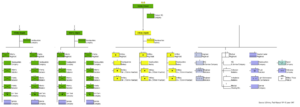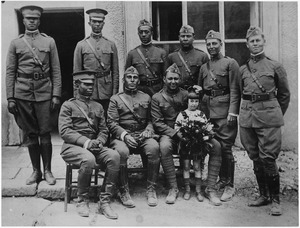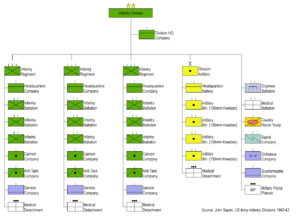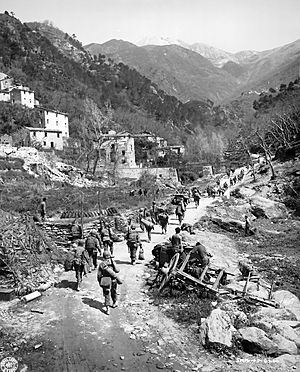92nd Infantry Division (United States) facts for kids
Quick facts for kids 92nd Division92nd Infantry Division (Colored) |
|
|---|---|

Shoulder sleeve insignia
|
|
| Active | 1917–1919 1942–1945 |
| Country | |
| Branch | |
| Type | Infantry |
| Size | Division |
| Nickname(s) | "Buffalo Soldiers" |
| Motto(s) | "Deeds, not Words" |
| Engagements | World War I
|
| Commanders | |
| Notable commanders |
Maj. Gen. Edward M. Almond |
| Insignia | |
| Distinctive unit insignia | 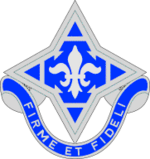 |
The 92nd Infantry Division was a special unit of the United States Army. It was made up of African Americans and served in both World War I and World War II. At that time, the military was segregated, meaning Black and white soldiers served in separate units.
The division was formed in October 1917, after the U.S. joined World War I. Soldiers came from all over the United States to Camp Funston, Kansas. In 1918, before going to France, the American buffalo was chosen as their symbol. This was because of the "Buffalo Soldiers" nickname. This name was given to African-American cavalrymen in the 1800s. The 92nd Division was often called the "Buffalo Soldiers Division."
During World War II, the 92nd Infantry Division was the only African-American infantry division to fight in Europe. Other African-American units mainly provided support. The 92nd Division was part of the U.S. Fifth Army. They fought in the Italian Campaign from 1944 until the war ended.
Contents
History of the Buffalo Soldiers Division
The 92nd Division in World War I
- Activated: October 1917
- Sent Overseas: July 18, 1918
- Main Battles: Meuse-Argonne
- Total Casualties: 1,647 (120 killed, 1,527 wounded)
- Returned to U.S. and Disbanded: February 1919
The 92nd Division was officially created on October 24, 1917. This was more than six months after the U.S. entry into World War I. Most of the time, the division was led by Major General Charles Clarendon Ballou. It included two infantry brigades, each with two regiments. There were also artillery, engineer, medical, and signal units.
The division was formed on October 27, 1917, from soldiers drafted from across the United States. The War Department spread the units out in different camps. These included Camp Funston in Kansas, Camp Dodge in Iowa, and Camp Upton in New York. All the enlisted soldiers were African American. About four out of five officers were also African American. However, most of the higher-ranking officers and those in supply, artillery, and engineering were white. Over 600 Black officers were trained for this division in Des Moines, Iowa.
A special area was built for Black soldiers at Camp Funston. It had separate places for fun and shopping. A local banker even gave land for a "community house" for the Black trainees.
Like the 93rd Division, parts of the 92nd Division served with the French Army. The main American Expeditionary Force (AEF) did not allow African-American soldiers to fight alongside white American soldiers. This was due to the racial policies of the time, which promoted "separate but equal" units.
When they arrived in France, the 92nd was a new unit. They didn't even have time to practice as a full division before being sent to the front lines. They began joining French front-line sectors in mid-August 1918. The 92nd Artillery Brigade joined the fight in October 1918. A Black reporter, Ralph Waldo Tyler, was assigned to report on the 92nd Division. He was the only African American reporting on the war at that time.
The 92nd Division fought in the Meuse-Argonne Offensive in November 1918.
Main Units of the 92nd Division (1917–1919)
- Headquarters, 92nd Division
- 183rd Infantry Brigade
- 365th Infantry Regiment
- 366th Infantry Regiment
- 350th Machine Gun Battalion
- 184th Infantry Brigade
- 367th Infantry Regiment
- 368th Infantry Regiment
- 351st Machine Gun Battalion
- 167th Field Artillery Brigade
- 349th Field Artillery Regiment
- 350th Field Artillery Regiment
- 351st Field Artillery Regiment
- 317th Trench Mortar Battery
- 349th Machine Gun Battalion
- 317th Engineer Regiment
- 317th Medical Regiment
- 317th Field Signal Battalion
- 325th Field Signal Battalion
- Headquarters Troop, 92nd Division
- 317th Train Headquarters and Military Police
The 92nd Infantry Division in World War II
- Activated: October 15, 1942
- Sent Overseas: September 22, 1944
- Campaigns: North Apennines, Po Valley
- Awards:
* Medal of Honor: 2 (one given after the soldier died, in 1997) * Distinguished Service Cross (United States): 2 * Silver Star: 208 * Bronze Star: 1,166 * Purple Heart: 1,891 * Many other awards from the U.S. and other countries.
- Returned to U.S.: November 26, 1945
- Disbanded: November 28, 1945
The division was brought back to life on October 15, 1942, with the "colored" designation. This was ten months after the U.S. joined World War II. It was led by Major General Edward Almond. The soldiers trained at Fort Huachuca, Arizona, for almost two years.
In July 1944, the 370th Infantry Regiment was sent to Italy. It temporarily joined the 1st Armored Division. The rest of the 92nd Division arrived in September 1944. The whole division then fought hard during the rest of the Italian Campaign.
While fighting in Italy, the Buffalo Soldiers met units from many different countries. They fought alongside the 442nd Regimental Combat Team (which included Japanese Americans). They also met soldiers from the British and French colonial empires, as well as Polish, Greek, Czech, and Brazilian troops. They even worked with Italians who were fighting against fascism.
The division had its own magazine called The Buffalo. Its art director, Ted Shearer, later created the famous African-American comic strip Quincy.
Division Commanders
The division's commander was Major General Edward Almond. He led the 92nd Division from its start in October 1942 until August 1945. He was in charge during all their combat in Italy from 1944 to 1945.
Combat Story
The 370th Regimental Combat Team arrived in Naples, Italy, on August 1, 1944. They began fighting on August 24. They helped cross the Arno River, take over Lucca, and break through the Gothic Line. At first, the enemy didn't fight back much in their area.
In October, parts of the 92nd attacked towards Massa. They made small gains, but enemy counterattacks pushed them back. On October 13, the rest of the division focused on patrol missions.
In November 1944, elements of the 92nd moved to the Serchio sector. They advanced in the Serchio River Valley with little resistance. However, they couldn't capture Castelnuovo di Garfagnana. Patrols continued until December 26, when the enemy attacked. This forced the 92nd units to pull back. The attack ended on December 28. The attacking forces included Italian Fascist troops and German battalions.
After some difficult battles, the U.S. Command decided to reorganize the 92nd Infantry Division. This was because they believed the division was better suited for defensive roles. In early 1945, the division was rebuilt. The 365th Infantry Regiment became a training unit. The 366th Infantry Regiment was used for engineer work. The 370th Infantry Regiment stayed with the division and was strengthened with good soldiers and officers. The 473rd Infantry Regiment and the highly effective Nisei 442nd Infantry Regiment (made up of Japanese Americans) were added to help the division fight better.
More recently, historians have been looking at the 92nd Division's combat record again. Many reports show that they performed honorably. Veterans of the division believed that earlier negative reports were unfair and caused by racism from some senior officers. Even with new evidence, some people still try to hide these facts.
On April 1, 1945, the 370th Regimental Combat Team and the attached 442nd Regimental Combat Team attacked the coastal area. They quickly moved north against light resistance from German forces. The 370th then took over the Serchio sector. They chased the retreating enemy from April 18 until all enemy forces collapsed on April 29, 1945. Parts of the 92nd Division entered La Spezia and Genoa on April 27. They took control of towns along the coast until the enemy surrendered on May 2, 1945.
Casualties of the 92nd Division
- Total battle casualties: 2,997
- Killed in action: 548
- Wounded in action: 2,187
- Missing in action: 206
- Prisoner of war: 56
Medal of Honor Recipients
The Medal of Honor is the highest military award for bravery. Two soldiers from the 92nd Division received this medal, though not until 1997:
- John R. Fox, 1st Lt., Cannon Company, 366th Infantry Regiment, near Sommocolonia, Italy, December 26, 1944.
- Vernon J. Baker, 1st Lt., Company C, 370th Infantry Regiment, near Viareggio, Italy, April 5–6, 1945.
Order of Battle (1942–1945)
92nd Infantry Division (1942–45)
- Headquarters, 92nd Infantry Division
- 365th Infantry Regiment
- 370th Infantry Regiment
- 371st Infantry Regiment
- Headquarters and Headquarters Battery, 92nd Infantry Division Artillery
- 597th Field Artillery Battalion (105 mm)
- 598th Field Artillery Battalion (105 mm)
- 599th Field Artillery Battalion (105 mm)
- 600th Field Artillery Battalion (155 mm)
- 317th Engineer Combat Battalion
- 317th Medical Battalion
- 92nd Cavalry Reconnaissance Troop (Mechanized)
- Headquarters, Special Troops, 92nd Infantry Division
- Headquarters Company, 92nd Infantry Division
- 792nd Ordnance (Light Maintenance) Company
- 92nd Quartermaster Company
- 92nd Signal Company
- Military Police Platoon
- Band
- 92nd Counterintelligence Corps Detachment
Attached units:
- 366th Infantry Regiment (November 1944 – February 1945)
- 442nd Infantry Regiment (Nisei) (April 1945 – )
- 473rd Regimental Combat Team (February 1945 – May 1945?)
- 758th Tank Battalion (Colored)
- 679th Tank Destroyer Battalion (Colored)
- 894th Tank Destroyer Battalion
- 701st Tank Destroyer Battalion
Task Force 1 (February 1945):
- 3rd Battalion / 366th Infantry Regiment
- Company B, 317th Engineer Battalion
- 760th Tank Battalion
- 84th Chemical Mortar Battalion
- 27th Armored Field Artillery Battalion
See also
 In Spanish: 92.ª División de Infantería (Estados Unidos) para niños
In Spanish: 92.ª División de Infantería (Estados Unidos) para niños
- Colonel Allen J. Greer, chief of staff, World War I
- Battle of Garfagnana, World War II
- James Harden Daugherty, soldier and author
- U.S. IV Army Corps, World Wars I and II
- Miracle at St. Anna, motion picture based on soldiers of this division


